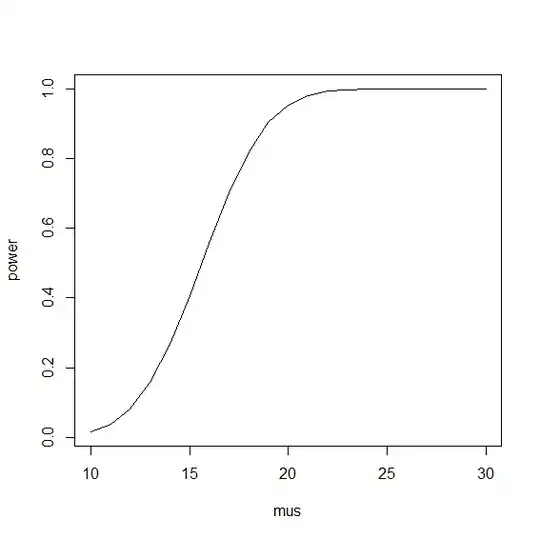Based on wikipedia (https://en.wikipedia.org/wiki/Symmetric_probability_distribution), a distribution is symmetric about $x_0$ if and only if it is a distribution whose pdf(or pmf) $f(\cdot)$ satisfies $f(x_0+x)=f(x_0-x)$ for any $x\in \mathbb{R}$. Can we also define symmetry about $x_0$ using cdf? That is, we say a distribution is symmetric about $x_0$ if and only if $F(x_0+x)=1-F(x_0-x)$ for any $x\in\mathbb{R}$. It seems that this definition is also okay, right?
-
2Take the derivative, $\dfrac{dF}{dx}$, and remember the chain rule. – Dave Oct 26 '20 at 19:49
-
@Dave Thanks, Dave! – T34driver Oct 26 '20 at 20:00
-
2When a distribution has a pmf, $F$ is not differentiable everywhere. The definition you give in the question works only for continuous distributions and fails for all distributions with pmfs (the discrete ones). A general definition is given at https://stats.stackexchange.com/questions/28992/what-is-the-definition-of-a-symmetric-distribution. To express that definition in terms of the CDF requires a limiting operation. – whuber Oct 26 '20 at 20:39
-
@whuber Thanks, Whuber! This is very helpful. Do you have a counterexample in mind that invalidates the discrete case? Thanks! – T34driver Oct 26 '20 at 21:20
-
3The simplest counterexample is a Bernoulli$(1/2)$ distribution, which is symmetric about $x_0=1/2.$ For $x=1/2$ notice that $1= F(1/2+1/2) \ne 1 - F(1/2-1/2)=1/2.$ However, $\lim_{x\uparrow \frac{1}{2}}F\left(\frac{1}{2}-x\right)=\frac{1}{2}=\lim_{x\uparrow \frac{1}{2}}F\left(\frac{1}{2}+x\right).$ – whuber Oct 26 '20 at 21:28
-
1@whuber Thanks! This is very clear! It makes sense that the cdf definition only works for the continuous case. – T34driver Oct 26 '20 at 21:43
1 Answers
You can characterize symmetry in terms of the CDF -- but it's a little tricky.
Recall that a random variable $X$ has a symmetric distribution when there exists a number $a$ for which $X$ and $2a-X$ have the same distribution function. Since this is the same thing as saying that $Y=X-a$ and $-Y=a-X$ have the same distribution, we lose no generality by analyzing the variable $Y.$ Let $F$ be its distribution function, which by definition is
$$F(y) = \Pr(Y\le y) = \Pr(X-a\le y) = \Pr(x \le a+y)$$
for all numbers $y.$ The symmetry of $Y$ implies
$$\begin{aligned} F(y) &= \Pr(Y\le y)\\ & = \Pr(-Y\le y) \\ & = \Pr(Y \ge -y) \\ & = \Pr(Y \gt -y) + \Pr(Y=-y)\\ & = (1-\Pr(Y \le -y))+\Pr(Y=-y)\\ & = 1 - F(-y) + \Pr(Y=-y). \end{aligned}$$
That extra term $\Pr(Y=-y)$ is a nuisance unless the distribution is continuous (which means that $\Pr(Y=-y)=0$ for all $y$). Our challenge is to express the probabilities $\Pr(Y=-y)$ in terms of the distribution function $F.$
To accomplish this, equate the set $\{-y\}$ with the intersection of the countable family of intervals $(-y-1/n,-y],$ $n=1,2,3,\ldots,$ and exploit the axioms of probability to deduce
$$\Pr(Y=-y) = \lim_{n\to\infty}\Pr\left(-y-\frac{1}{n} \lt Y \le -y\right) = F(-y) -\lim_{\epsilon\downarrow 0} F(-y-\epsilon).$$
Substituting this into the foregoing equation for $F(y)$ leads to the general characterization
$F$ is symmetric around $0$ if and only if $$F(y) = 1 - \lim_{\epsilon\downarrow 0}F(-y-\epsilon).$$
As an example, consider this graph of $F$ when $X$ has a Bernoulli$(1/2)$ distribution. Here, the center of symmetry is $a=1/2,$ so $Y = X-1/2$ takes on the values $\pm 1/2$ each with probability $1/2.$
The definition of $F$ causes its values at each jump to be the upper limit, whereas changing $F$ to $1-F(-y)$ rotates its graph around its center at $(0,1/2),$ thereby switching the "up" and "down" directions and causing the graph to attain the lower values at each jump. We fix that in the definition of $\tilde F$ by sneaking up to the jumps from the left side, as shown in the right hand panel.
We may summarize this English characterization, and re-introduce the center of symmetry $a$ for full generality, by stating
A distribution function $F$ is symmetric around a number $a$ if and only if it coincides with the function obtained from $F$ whose graph (a) uses the lower values at each jump and (b) is rotated around the central point $(a,1/2)$ by 180 degrees.
- 281,159
- 54
- 637
- 1,101
